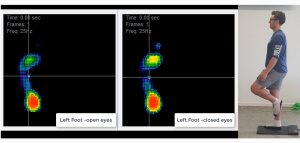Balance Assessment using Plantar Pressure Analysis
Elective Unit
Core Information
The assessment of balance is incredibly important for so many of the patients we see in our daily clinical practice. The use of plantar pressure equipment adds an extra dimension to the already validated assessment tools by providing you with an inside view of how the body functions in an interactive way during quiet stance and dynamic gait.
We are familiar with the concept of balance assessment for patients who are at risk of falls due to their age, but for so many other patients balance assessment using plantar pressure analysis will provide us with a greater understanding of the overall effects of their condition.
When a patient has a total hip or knee replacement later in life or any foot or ankle surgery, it has huge potential for causing imbalances and changes of proprioception. The body will adapt to this but in doing so, may develop pathways of weight-bearing which may overload tissues and result in injuries. Assessing a patient’s balance after they’ve gone through their initial rehabilitation program post surgery will provide you with the fine tuning needed to ensure that a resulting leg length difference or muscle imbalance from the surgery has been accommodated either through a strengthening and conditioning course or perhaps some type of orthomechanical therapy.
A balance assessment is also really important for people who have a neuropathic condition such as Parkinson’s, multiple sclerosis, cerebral palsy and people who survived strokes and TIAs. Also, for patients with diminished or lack of protective sensation in the feet due to conditions such as diabetes, as we know a neuropathic foot can reduce the protective function of the foot and may also reduce the effectiveness of the proprioceptors, having an effect on the balance.
Not forgetting how important the skill of good balance and stability is in so many sports. Whether it’s assessment of injury risk, deciding when the player is ready to return to sport or even improving their technique, balance assessment can provide valuable information to help us with the decision process and provide our patient with the very best outcome possible.
When you purchase this course you have permanent access to a Learning Dashboard containing the webinar videos and other resources.
Content includes:
- 6 X 20 – 30 minute (approximately) lessons
- Resources appropriate to the course are provided for you to ensure understanding and ability to use learned knowledge to gain expected outcomes in your own clinic.
- Test questions for each lesson to assist your understanding and for you to receive an Achievement Certificate at the completion of the course.
Bonus
30-minute one on one online consultation to assist you to best use the content in you own practice environment and patient caseload.

